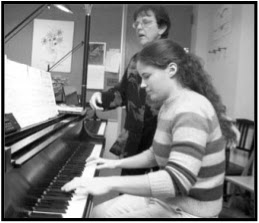Note-reading - In a traditional method the first thing a child will do is start learning how to read notes. While this is a vital part of music, the Suzuki method uses the Mother-Tongue Method. Dr. Shinichi Suzuki believed that if every child could learn to speak his/her native language fluently, then every child could learn to play music fluently using the same steps.
Listening - infants develop their hearing while still in the womb at week 16 and typically start forming words around 12 months. The first assignment your child has as a Suzuki student is to listen to the Book 1 CD which plays all of the songs they will be learning.
Imitating - children always imitate their parents, whether you want them to or not! In the Suzuki Method the parent starts by taking lessons and practicing at home, then when the parent is ready the child copies the parent in taking lessons and practicing.
Repetition - children love to play the same games, watch the same shows, eat the same food, etc. We use that to our advantage by constantly repeating our review songs to solidify technique.
Reading - after a child has successfully learned to speak, they will learn to read and write. Every Suzuki teacher starts note-reading at a slightly different time because it depends on the child's readiness, but I typically introduce note-reading at the end of Book 1 or beginning of Book 2.
Parental Involvement - When I was young my Mom dropped us off for our piano lessons (along with $.25 for candy!) and went to do her grocery shopping. It wasn't until I was in college that I finally let her sit in on a piano lesson. I so wish I could go back and have her at every lesson so that she could help me and guide me at home. Since the Suzuki method allows starting students very young, usually at 3 or 4 year old, it's impossible to expect a child that age to take the responsibility of practicing alone at home. Not only that, but it makes a huge difference in the child's success to have the parent involved. Parents, you don't have to know a thing about music to be able to help your children, although you will learn along with your child as you sit in the lessons. You provide stability, partnership, guidance, and fun in the practice sessions at home. Sometimes when your child gets frustrated with something, it helps them to see that you're puzzled by the same thing.
 |
| A piano lesson with Mrs. Phyllis East |
Repertoire - Most traditional teachers use an array of different method books, and once students reach a certain level they will skip around to find songs the student may enjoy, rather than songs specifically chosen to teach the next step. While this is not a hopeless way of learning, it can be difficult to see progress. The Suzuki method has graded repertoire, all chosen to teach a specific point in a specific order, much like the progression in grade school math. Another benefit to this is that beginner students get to hear more advanced students play the songs they will be learning in the future and are constantly inspired and motivated by them.
Teacher's Accreditation - Obviously, any pianist will reach a level in their musical education, whether they take lessons through High School, or go on for a college degree, which qualifies them to teach piano lessons. The Suzuki Association has taken it upon themselves to make sure that their teachers are not only accomplished performers, but also prepared teachers. To become a Suzuki Certified teacher you must pass an audition process before taking training in each individual book (7 books total for piano) in order to teach the material. If you are interested in taking Suzuki lessons, always make sure that the teacher you're considering is certified. Unfortunately, there are many teachers out there using the repertoire who have not had the training.
I know this post has been lengthy, but I hope it has answered questions and sparked more interest for this amazing way of learning! My goal as a Suzuki teacher is to teach through love and enthusiasm, and develop a love for music in my students.
No comments:
Post a Comment